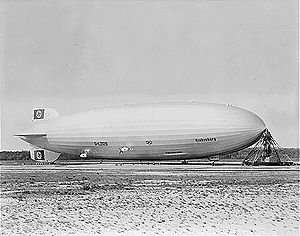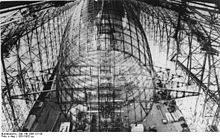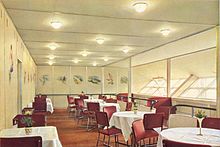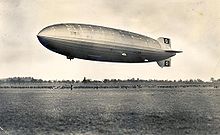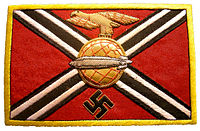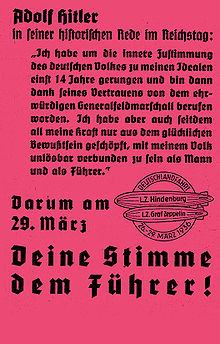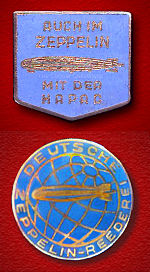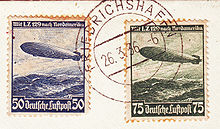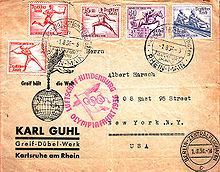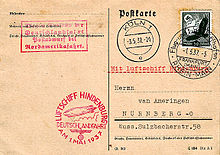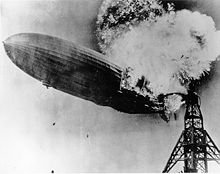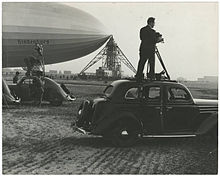- LZ 129 Hindenburg
-
"The Hindenburg" redirects here. For other uses, see Hindenburg.
Hindenburg Hindenburg Type Hindenburg-class airship Manufacturer Luftschiffbau Zeppelin GmbH Construction number LZ 129 Manufactured 1931-36 Registration D-LZ 129 First flight 4 March 1936 Owners and operators Deutsche Zeppelin Reederei In service 1936-37 Flights 63 Fate Destroyed in fire May 6, 1937 LZ 129 Hindenburg (Luftschiff Zeppelin #129; Registration: D-LZ 129) was a large German commercial passenger-carrying rigid airship, the lead ship of the Hindenburg class, the longest class of flying machine and the largest airship by envelope volume.[1] Designed and built by the Zeppelin Company (Luftschiffbau Zeppelin GmbH) on the shores of the Bodensee (Lake Constance) in Friedrichshafen, the airship flew from March 1936 until destroyed by fire 14 months later on May 6, 1937, at the end of the first North American transatlantic journey of its second season of service. Thirty-six people died in the accident, which occurred while landing at Lakehurst Naval Air Station in Manchester Township, New Jersey, United States.
Hindenburg was named after the late Field Marshal Paul von Hindenburg (1847–1934), President of Germany (1925–1934).
Contents
Design and development
Main article: Hindenburg-class airshipThe Hindenburg had a duralumin structure, incorporating 15 Ferris wheel-like bulkheads along its length, with 16 cotton gas bags fitted between them. The bulkheads were braced to each other by longitudinal girders placed around their circumferences. The airship's skin was of cotton doped with a mixture of reflective materials intended to protect the gas bags within, which were made of goldbeater's skin, from both ultraviolet (which would damage them) and infrared (which might cause them to overheat) radiation. In 1931 the Zeppelin Company purchased 5,000 kg of duralumin salvaged from the wreckage of the October 1930 crash of the British airship R101, which might have been re-cast and used in the construction of the Hindenburg.[2]
The interior furnishings of the Hindenburg were designed by Fritz August Breuhaus, whose design experience included Pullman coaches, ocean liners, and warships of the German Navy.[3] The upper A Deck contained small passenger quarters in the middle flanked by large public rooms: a dining room to port and a lounge and writing room to starboard. Paintings on the dining room walls portrayed the Graf Zeppelin's trips to South America. A stylized world map covered the wall of the lounge. Long slanted windows ran the length of both decks. The passengers were expected to spend most of their time in the public areas, rather than their cramped cabins.[4]
The lower B Deck contained washrooms, a mess hall for the crew, and a smoking lounge. Harold G. Dick, an American representative from the Goodyear Zeppelin Company,[5] recalled "The only entrance to the smoking room, which was pressurized to prevent the admission of any leaking hydrogen, was via the bar, which had a swiveling air lock door, and all departing passengers were scrutinized by the bar steward to make sure they were not carrying out a lighted cigarette or pipe."[6][7]
Use of hydrogen instead of helium
Helium was initially selected[8] for the lifting gas because it was the safest to use in airships, as it is not flammable. At the time it was extremely expensive, and was only available from natural gas reserves in the United States. Hydrogen, by comparison, could be cheaply produced by any industrialized nation and had more lift. American rigid airships using helium were forced to conserve the gas at all costs and this hampered their operation.[9] While a hydrogen-filled ship could routinely vent gas as necessary, a helium-filled ship had to resort to dynamic force if it was too light to descend, a measure that took a toll on its structure.[citation needed]
Despite a U.S. ban on helium exports, the Germans designed the ship to use the gas in the belief that the ban would be lifted; when the designers learned that the ban was to remain in place, they were forced to re-engineer the Hindenburg to use hydrogen for lift.[8] Despite the danger of using flammable hydrogen, no alternative gases that could provide sufficient lift could be produced in sufficient quantities. One beneficial side effect of employing hydrogen was that more passenger cabins could be added. The Germans' long history of flying hydrogen-filled passenger airships without a single injury or fatality engendered a widely held belief they had mastered the safe use of hydrogen. The Hindenburg's first season performance appeared to demonstrate this.
Operational history
Launching and trial flights
Five years after construction began in 1931, the Hindenburg made its maiden test flight from the Zeppelin dockyards at Friedrichshafen on March 4, 1936, with 87 passengers and crew aboard. These included the Zeppelin Company chairman, Dr. Hugo Eckener, as commander, former World War I Zeppelin commander Lt. Col. Joachim Breithaupt representing the German Air Ministry, the Zeppelin company's eight airship captains, 47 other crew members, and 30 dockyard employees who flew as passengers.[10] Although the name Hindenburg had been quietly selected by Eckener over a year earlier,[11] only the airship's formal registration number (D-LZ129) and the five Olympic rings (promoting the 1936 Summer Olympics to be held in Berlin that August) were displayed on the hull during its six trial flights. However, as the airship passed over Munich on its second trial flight the next afternoon, that city's Lord Mayor, Karl Fiehler, asked Eckener by radio the LZ129's name, to which he replied "Hindenburg".
The Zeppelin Company chairman’s public pronouncement of the name greatly angered Propaganda Minister Joseph Goebbels, however, who immediately summoned Eckener to Berlin for a meeting the next day, at which the Nazi minister bluntly stated that he wanted the airship to be renamed the Adolf Hitler. When Eckener refused to do so, Goebbels then decreed that the airship would be referred to in Germany only as "LZ 129" and also warned Eckener that he could easily make the world-famous airshipman a "non-person" in the German media.[12] Although the name Hindenburg lettered in 6-foot-high (1.8 m) red script was finally added to its hull three weeks later, no formal naming ceremony for the airship was ever held.[13]
The airship was operated commercially by the Deutsche Zeppelin Reederei GmbH (DZR), which had been established by Hermann Göring in March 1935 to increase Nazi influence over zeppelin operations.[14] The DZR was jointly owned by the Luftschiffbau Zeppelin (the airship's builder), the Reichsluftfahrtministerium (German Air Ministry), and Deutsche Lufthansa A.G. (Germany's national airline at that time), and also operated the LZ 127 Graf Zeppelin during its last two years of commercial service to South America from 1935 to 1937. The Hindenburg and its sister ship, the LZ 130 Graf Zeppelin II (launched in September 1938), were the only two airships ever purpose-built for regular commercial transatlantic passenger operations, although the latter never entered passenger service before being scrapped in 1940.
After a total of six trial flights made over a three-week period from the Zeppelin dockyards where the airship had been built, the Hindenburg was ready for its formal public debut with a 4,100-mile (6,598 km) propaganda flight around Germany (Die Deutschlandfahrt) made jointly with the Graf Zeppelin from March 26 to 29.[15] This was to be followed by its first commercial passenger flight, a four-day transatlantic voyage to Rio de Janeiro that departed from the Friedrichshafen Airport in nearby Löwenthal on March 31.[16] After again departing from Löwenthal on May 6 on its first of 10 round trips to North America made in 1936,[17] all subsequent transatlantic operations flown by the Hindenburg to both North and South America originated at the airport at Frankfurt am Main.[18][19]
Die Deutschlandfahrt
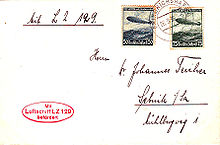 Cover carried on the Hindenburg during the 1936 Deutschlandfahrt
Cover carried on the Hindenburg during the 1936 Deutschlandfahrt
Although designed and built for commercial transatlantic passenger and mail service, at the behest of the Reich Ministry for Public Enlightenment and Propaganda (Reichsministerium für Volksaufklärung und Propaganda or Propagandaministerium), the Hindenburg was first impressed into use by the Air Ministry (its DLZ co-operator) as a vehicle for the delivery of Nazi propaganda.[20] On March 7, 1936, ground forces of the German Reich had entered and occupied the Rhineland, a region bordering the Netherlands, Luxembourg, Belgium, and France, which had been designated in the 1920 Treaty of Versailles as a de-militarized zone established to provide a buffer between Germany and those neighboring countries.
In order to justify its remilitarization — which was also a violation of the 1925 Locarno Pact,[21] — a "post hoc" plebiscite (or referendum) was quickly called by Hitler for March 29 to "ask the German people" to both ratify the Rhineland’s occupation by the German Army, and to approve a single party list composed exclusively of Nazi candidates to sit in the new Reichstag. The Hindenburg and the Graf Zeppelin were designated by the government as a key part of the process.[22]
As a public relations ploy, Propaganda Minister Goebbels demanded that the Zeppelin Company make the two airships available to fly "in tandem" around Germany over the four day period prior to the voting with a joint departure from Löwenthal on the morning of March 26.[23] While gusty wind conditions that morning would prove to make the process of safely launching the new airship a difficult one, the Hindenburg's commander, Captain Ernst Lehmann, was determined to impress the politicians, Nazi party officials, and press present at the airfield with an "on time" departure and thus proceeded with its launch despite the unfavorable conditions. However, as the massive airship began to rise under full engine power it was caught by a 35-degree crosswind gust, causing its lower vertical tail fin to strike and be dragged across the ground, resulting in significant damage to the bottom portion of the airfoil and its attached rudder.[24][25]
Zeppelin Company Chairman Eckener, who had opposed the joint flight both because it politicized the airships and had forced the cancellation of an essential final endurance test for the Hindenburg, was furious and rebuked Lehmann:
"How could you, Mr. Lehmann, order the ship to be brought out in such windy conditions? You had the best excuse in the world for postponing this idiotic flight; instead, you risk the ship, merely to avoid annoying Mr. Goebbels. Do you call this showing a sense of responsibility towards our enterprise?"[26]
The Graf Zeppelin, which had been hovering above the airfield waiting for the Hindenburg to join it, thus had to start off on the propaganda mission alone while the LZ 129 was returned to its hangar, where temporary repairs were quickly made to its empennage before joining up with the smaller airship several hours later.[27] As millions of Germans watched from below, the two giants of the sky sailed over Germany for the next four days and three nights, dropping propaganda leaflets, blaring martial music and slogans from large loudspeakers, and broadcasting political speeches from a makeshift radio studio on board the Hindenburg.[28]
First commercial passenger flight
With the completion of voting on the referendum (which the Government claimed had been approved by a "98.79% 'Yes' vote"[29]), the Hindenburg returned to Löwenthal on March 29 to prepare for its first commercial passenger flight, a transatlantic passage to Rio de Janeiro scheduled to depart from there on March 31.[30] Hugo Eckener was not to be the commander of the flight, however, but instead was relegated to being a "supervisor" with no operational control over the Hindenburg while Ernst Lehmann had command of the ship.[31] To add insult to injury, Eckener learned from an Associated Press reporter upon the Hindenburg's arrival in Rio that Goebbels had also followed through on his month-old threat to decree that Eckener's name would "no longer be mentioned in German newspapers and periodicals" and "no pictures nor articles about him shall be printed."[32] This action was taken because of Eckener's opposition to using the Hindenburg and Graf Zeppelin for political purposes during the Deutschlandfahrt, and his "refusal to give a special appeal during the Reichstag election campaign endorsing Chancellor Adolf Hitler and his policies."[33] (Although the existence of the ban was never publicly acknowledged by Goebbels, it was quietly lifted a month later.[34])
The first South America flight itself was not trouble free for the Hindenburg either, as one of the airship's four Daimler-Benz 16-cylinder diesel engines suffered a wrist pin breakage during the outbound leg, and although repairs were made at Recife the engine could no longer deliver full power. A similar problem developed on the return journey when another engine failed off the African Gold Coast near Morocco, and as mechanics were attempting to repair it a second stalled and could not be restarted. By then running on just two of its four powerplants, the Hindenburg was in danger of drifting into the Sahara Desert, where a forced landing made without a ground crew and mooring mast available would have likely resulted in the airship having to be written off as damaged beyond repair. To avoid such a catastrophe, the crew raised the airship in search of counter-trade winds usually found above 5,000 feet (1,500 m), well beyond the airship's pressure height. Unexpectedly, however, the crew found such a favorable wind at a lower altitude [3,600 feet (1,100 m)], which permitted them to guide the airship safely back to Germany after also getting emergency permission from France to fly a more direct route over the Rhone Valley. The nine-day flight covered 12,756 miles (20,529 km) in 203 hours and 32 minutes of flight time.[35] All four engines were later overhauled, and no subsequent problems were encountered on later flights.[36]
The 1936 transatlantic season
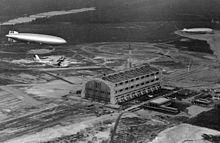 LZ 129 arrival at Lakehurst, May 9, 1936. USS Los Angeles (ZR-3) is moored upper right.
LZ 129 arrival at Lakehurst, May 9, 1936. USS Los Angeles (ZR-3) is moored upper right.
The Hindenburg made 17 round trips across the Atlantic Ocean in 1936, its first and only full year of service, with 10 trips to the United States and seven to Brazil. In July 1936, the airship also completed a record Atlantic double crossing in five days, 19 hours and 51 minutes. Among the famous passengers who traveled on the airship was German heavyweight boxing champion Max Schmeling, who returned home on the Hindenburg to a hero's welcome after knocking out Joe Louis in New York on June 19, 1936.[37] During the 1936 season the airship flew 191,583 miles (308,323 km), carried 2,798 passengers, and transported 160 tons of freight and mail, a level of success that encouraged the Luftschiffbau Zeppelin Company to plan the expansion of its airship fleet and transatlantic services.
The ship was reportedly so stable that a pen or pencil could be stood on a table without falling. Its launches were so smooth that passengers often missed them, believing that the airship was still on the ground. The cost of a ticket between Germany and the United States was US$400 (about US$6,300 in 2010 dollars[38]), a considerable sum in the Depression era. Hindenburg passengers were generally affluent, including many public figures, entertainers, noted sportsmen, political figures, and leaders of industry.[39][40]
The Hindenburg was used again for propaganda purposes and on August 1 it flew over the Olympic Stadium in Berlin during the opening ceremonies of the 1936 Summer Olympic Games. Shortly before the arrival of Adolf Hitler to declare the Games open, the airship crossed low over the packed stadium while trailing the Olympic flag on a long weighted line suspended from its gondola.[41]
During 1936 the Hindenburg had a special aluminium Blüthner grand piano placed on board in the music salon, although the instrument was removed after the first year to save weight.[42]
Over the winter of 1936–37, several changes were made. The greater lift capacity allowed 10 passenger cabins to be added, nine with two beds and one with four beds, increasing the total passenger capacity to 72.[43] In addition, "gutters" were installed to collect rain for use as water ballast.
Another change was the installation of an experimental aircraft hook-on trapeze based on the system similar to the one used on the US Navy Goodyear-Zeppelin built airships USS Akron (ZRS-4) and USS Macon (ZRS-5). This was intended to allow customs officials to be flown out to the Hindenburg to process passengers before landing and to retrieve mail from the ship for early delivery. Experimental hook-ons and takeoffs were attempted on March 11 and April 27, 1937, but were not very successful, owing to turbulence around the area where the hook-up trapeze had been mounted. The loss of the ship ended all prospects of further testing.[44]
The final flight: May 3–6, 1937
Main article: Hindenburg disasterAfter making the first South American flight of the 1937 season in late March, the Hindenburg left Frankfurt for Lakehurst on the evening of May 3 on its first scheduled round trip between Europe and North America that season. Although strong headwinds slowed the crossing, the flight had otherwise proceeded routinely as it approached for a landing three days later.[45]
The Hindenburg's arrival on May 6 was delayed for several hours to avoid a line of thunderstorms passing over Lakehurst, but around 7:00 p.m. the airship was cleared for its final approach to the Naval Air Station, which it made at an altitude of 650 ft (200 m) with Captain Max Pruss at the helm. However, as ground handlers grabbed hold of a pair of landing lines dropped from the nose of the ship at 7:21 p.m., the Hindenburg suddenly burst into flames and dropped to the ground in just 37 seconds. Of the 36 passengers and 61 crew on board, 13 passengers and 22 crew died, as well as one member of the ground crew, making a total of 36 lives lost in the disaster.[46][47][48]
 A fire scorched Duralumin Hindenburg cross brace salvaged from the crash site.
A fire scorched Duralumin Hindenburg cross brace salvaged from the crash site.
The location of the initial fire, the source of ignition, and the initial source of fuel remain subjects of debate. The cause of the accident has never been determined, although many hypotheses have been proposed. Escaping hydrogen gas will burn after mixing with air. The covering also contained material (such as cellulose nitrate and aluminum flakes) which some experts claim are highly flammable.[49] This, however, is highly controversial and has been rejected by some researchers because the outer skin burns too slowly to account for the rapid flame propagation.[45] The duralumin framework of the Hindenburg was salvaged and shipped back to Germany. There the scrap was recycled and used in the construction of military aircraft for the Luftwaffe, as were the frames of the LZ 127 Graf Zeppelin and LZ 130 Graf Zeppelin II when they were scrapped in 1940.[50]
Notable appearances in media
- Actual footage of the Hindenburg is shown in the 1937 Charlie Chan film Charlie Chan at the Olympics, which depicts Chan onboard for a flight across the Atlantic to attend the 1936 Summer Olympics in Berlin. The movie was released 15 days after the actual Hindenburg disaster on May 21, 1937.
- The image of the airship exploding was used as the cover of Led Zeppelin's self-titled debut album (1969).[51]
- The Hindenburg is a 1975 film inspired by the disaster, but centered around the sabotage theory; the some of these plot elements were based on real bomb threats before the flight began, as well as proponents of the sabotage theory. * The 2011 television-movie Hindenburg for RTL is also fictionally based on sabotage, with a fictional storyline. In this movie, however, the bomb is de-fused but the ship explodes due to static electricity.
- In the original theatrical release of the film Indiana Jones and the Last Crusade (1989), Indiana Jones travels on the Hindenburg. The name was digitally removed from the Zeppelin's fixtures in subsequent releases, apparently because the film's events took place in 1938 and the Hindenburg was actually destroyed a year earlier in 1937. Jones also escapes the zeppelin via a trapeze-mounted parasite fighter biplane, a system experimentally installed on the Hindenburg in early Spring 1937.[52]
- The plot of the third book of the Pendragon fantasy book series, The Never War (2003) is based on the Hindenburg disaster.
- Episodes in the 2009 airing of the television show Mythbusters included extensive testing related to the circumstances of the Hindenburg disaster.
- The title story of Jim Shepard's short story collection Love and Hydrogen takes place on the Hindenburg.
- In Neal Stephenson's Cryptonomicon the main character happens upon the Hindenburg in the midst of the disastrous fire
- In an episode of The Waltons John Boy Walton, played by Richard Thomas, returns as a newspaper reporter covering the arrival of The Hindenberg, and watches as it explodes.
Specifications
Data from Airships: A Hindenburg and Zeppelin History site[1]
General characteristics
- Crew: 40 to 61
- Capacity: 50-72 passengers
- Length: 245 m (803 ft 10 in)
- Diameter: 41 ? m (135.1 ft 0 in)
- Volume: 200,000 m3 (7,062,000 ft3)
- Powerplant: 4 × Daimler-Benz DB 602 diesel engines, 890 kW (1,200 hp) each
Performance
- Maximum speed: 135 km/h (85 mph)
See also
- Hindenburg class airship
- The Zeppelin Museum Friedrichshafen displays a reconstruction of a 33 m section of the Hindenburg.
- Timeline of hydrogen technologies
References
- Notes
- Citations
- ^ a b "Hindenburg Statistics." airships.net, 2009. Retrieved: May 6, 2010.
- ^ "R101: the Final Trials and Loss of the Ship." The Airship Heritage Trust. Retrieved: 27 October 2010.
- ^ Lehmann 1937, p. 319.
- ^ Dick and Robinson 1985, p. 96.
- ^ "The Goodyear Zeppelin Company." Ohio History Central. Retrieved: 27 October 2010.
- ^ Dick and Robinson 1985, p. 97.
- ^ "LZ-129 The Latest Airship," Popular Mechanics, June 1935.
- ^ a b MacGregor, Anne. "The Hindenburg Disaster: Probable Cause" (Documentary film). Moondance Films/Discovery Channel, Broadcast air date: 2001.
- ^ Vaeth 2005, p. 38.
- ^ Lehmann 1937, p. 323.
- ^ "The Airship." British Quarterly Journal, Spring 1935.
- ^ Mooney 1972, pp. 77–78.
- ^ "Today in History: Hindenburg’s First Flight, March 4, 1936." Airships.net. Retrieved: 27 October 2010.
- ^ "Deutsche Zeppelin-Reederei (DZR)". Airships.net. Retrieved: 27 October 2010.
- ^ Lehmann 1937, pp. 323–332.
- ^ Lehmann 1937, p. 341.
- ^ "Hindenburg Begins First U.S. Flight." New York Times, May 7, 1936.
- ^ "Hindenburg is off on 2d U.S. Flight." New York Times, May 17, 1936.
- ^ "Hindenburg Flight Schedules." Airships.net. Retrieved: 27 October 2010.
- ^ "Propaganda 'attack' made by Zeppelins." New York Times, March 29, 1936.
- ^ "Belgium Insistent on Locarno Terms." New York Times, March 12, 1936.
- ^ "Two Reich Zeppelins on Election Tour." New York Times, March 27, 1936.
- ^ "Photograph of the Hindenburg and Graf Zeppelin preparing to depart Löwenthal on Die Deutschlandfahrt." specialcollections.wichita.edu. Retrieved: January 11, 2010.
- ^ Lehmann 1937, p. 326.
- ^ "Photograph by Harold Dick of damaged lower vertical tail fin." specialcollections.wichita.edu. Retrieved: January 11, 2010.
- ^ Eckener 1958, pp. 150–151.
- ^ "Photograph by Harold Dick of temporary repair to lower vertical tail fin." specialcollections.wichita.edu. Retrieved: January 11, 2010.
- ^ Lehmann 1937, pp. 326–332.
- ^ "Hitler gets biggest vote: Many blanks counted in, 542,953 are invalidated." New York Times, March 30, 1936.
- ^ Mooney 1972, pp. 82–85.
- ^ "Transport: Von Hindenburg to Rio." Time, April 13, 1936.
- ^ Mooney 1972, p. 86.
- ^ "Eckener Refused Election Plea for Hitler: Name Barred From the Press as a Result." New York Times, April 3, 1936.
- ^ "'Eckener's Disgrace Ends: Zeppelin Expert is Victor in Clash with Goebbels." New York Times, April 30, 1936.
- ^ "Two Motors Crippled as Zeppelin Lands." New York Times, April 11, 1936.
- ^ Lehmann 1937, pp. 341–342.
- ^ Berg, Emmett. "Fight of the Century." Humanities, Vol. 25, No. 4, July/August 2004. Retrieved: January 7, 2008.
- ^ "Data." data.bls.gov. Retrieved: May 12, 2010.
- ^ Grossman, Dan. "Hindenburg’s Maiden Voyage Passenger List." Airships.net. Retrieved: May 9, 2010.
- ^ Toland 1972, p. 9.
- ^ Birchall 1936
- ^ "A History of the Blüthner Piano Company." bluthnerpiano.com. Retrieved: January 7, 2008.
- ^ Mooney 1972, p. 95.
- ^ Dick and Robinson 1985, pp. 142-145.
- ^ a b "Cause of the Hindenburg Disaster." Aerospaceweb.org. Retrieved: January 11, 2010.
- ^ Thompson, Craig. "Airship Like a Giant Torch On Darkening Jersey Field: Routine Landing Converted Into Hysterical Scene in Moment's Time--Witnesses Tell of 'Blinding Flash' From Zeppelin." New York Times, 7 May 1937.
- ^ "The Hindenburg Disaster." Airships.net. Retrieved: 27 October 2010.
- ^ Morrison, Herbert. "Live radio account of arrival and crash of the Hindenburg." Radio Days via OTR.com. Retrieved: 27 October 2010.
- ^ "Hydrogen Exonerated in Hindenburg Disaster." hydrogenus.com. Retrieved: January 11, 2010.
- ^ Mooney 1972, p. 262.
- ^ Davis 1995, pp. 32, 44.
- ^ " 'Indiana Jones and the Last Crusade'." imdb.com. Retrieved: January 11, 2010.
- Bibliography
- Airship Voyages Made Easy (16 page booklet for "Hindenburg" passengers). Friedrichshafen, Germany: Luftschiffbau Zeppelin G.m.b.H. (Deutsche Zeppelin-Reederei), 1937.
- Archbold, Rick. Hindenburg: An Illustrated History. Toronto: Viking Studio/Madison Press, 1994. ISBN 0-670-85225-2.
- Birchall, Frederick. "100,000 Hail Hitler; U.S. Athletes Avoid Nazi Salute to Him". The New York Times, 1 August 1936, p. 1.
- Botting, Douglas. Dr. Eckener's Dream Machine: The Great Zeppelin and the Dawn of Air Travel. New York: Henry Holt & Co., 2001. ISBN 0-8050-6458-3.
- Davis, Stephen. Hammer of the Gods: The Led Zeppelin Saga (LPC). New York: Berkley Boulevard Books, 1995. ISBN 0-42518-213-4.
- Dick, Harold G. and Douglas H. Robinson. The Golden Age of the Great Passenger Airships Graf Zeppelin & Hindenburg. Washington, DC: Smithsonian Institution Press, 1985. ISBN 1-56098-219-5.
- Duggan, John. LZ 129 "Hindenburg": The Complete Story. Ickenham, UK: Zeppelin Study Group, 2002. ISBN 0-9514114-8-9.
- Eckener, Hugo, translated by Douglas Robinson. My Zeppelins. London: Putnam & Co. Ltd., 1958.
- Hindenburg's Fiery Secret (DVD). Washington, DC: National Geographic Video, 2000.
- Hoehling, A.A. Who Destroyed The Hindenburg? Boston: Little, Brown and Company, 1962. ISBN 0-445-08347-6.
- Lehmann, Ernst. Zeppelin: The Story of Lighter-than-air Craft. London: Longmans, Green and Co., 1937.
- Majoor, Mireille. Inside the Hindenburg. Boston: Little, Brown and Company, 2000. ISBN 0-316-123866-2.
- Mooney, Michael Macdonald. The Hindenburg. New York: Dodd, Mead & Company, 1972. ISBN 0-396-06502-3.
- Toland, John. The Great Dirigibles: Their Triumphs and Disasters. Mineola, NY: Dover Publishers, 1972.
- Vaeth, Joseph Gordon. They Sailed the Skies: U.S. Navy Balloons and the Airship Program. Annapolis MD: Naval Institute Press, 2005. ISBN 978-1-59114-914-9.
External links
- "Hindenburg - End Of A Successful Voyage (Standard 4:3) (1937)". Pathgrams. http://www.archive.org/details/SF146. Retrieved February 21, 2009. (film shows docking team, passengers)
- "Hindenburg - Passengers Disembarking (Standard 4:3) (1937)". Pathgrams. http://www.archive.org/details/SF148. Retrieved February 21, 2009. (film of passengers descending ramp)
- Technical Drawing of the LZ 129 Hindenburg
- Airships.net: Detailed history and photographs of interior and exterior of LZ-129 Hindenburg
- "The Hindenburg Makes Her Last Standing at Lakehurst", Life Magazine article from 1937
- eZEP.de, The webportal for Zeppelin mail and airship memorabilia
- Hindenburg: Sky Cruise. Illustrated account of a flight on the Hindenburg - with maiden voyage and final flight passenger lists
- Harold G. Dick Airship Collection - lists of contents of the collection
- ZLT Zeppelin Luftschifftechnik GmbH & Co KG. The modern Zeppelin company
- The Hindenburg at Navy Lakehurst Historical Society
- "The Air Liners Of The Future." Popular Mechanics, February 1930, the future of dirigibles as aviation experts predicted in 1930, drawings on pages 220 and 221 shows how aviation experts saw the Hindenburg then under construction, including an overhead glass covered dance floor
- "Super Zepp To Have All Luxuries Of A Liner."Popular Mechanics, July 1932, early drawing of future Hindenburg
- "Biggest Birds That Ever Flew." Popular Science, May 1962
Aircraft produced or designed by Luftschiffbau Zeppelin Lighter-than-air LZ1 · LZ2 · LZ3 · LZ4 · LZ5 · LZ6 · LZ7 · LZ8 · LZ9 · LZ10 · LZ11 · LZ12 · LZ13 · LZ14 · LZ15 · LZ16 · LZ17 · LZ18 · LZ19 · LZ20 · LZ21 · LZ22 · LZ23 · LZ24 · LZ25 · LZ26 · LZ27 · LZ28 · LZ29 · LZ30 · LZ31 · LZ32 · LZ33 · LZ34 · LZ35 · LZ36 · LZ37 · LZ38 · LZ39 · LZ40 · LZ41 · LZ42 · LZ43 · LZ44 · LZ45 · LZ46 · LZ47 · LZ48 · LZ49 · LZ50 · LZ51 · LZ52 · LZ53 · LZ54 · LZ55 · LZ56 · LZ57 · LZ58 · LZ59 · LZ60 · LZ61 · LZ62 · LZ63 · LZ64 · LZ65 · LZ66 · LZ67 · LZ68 · LZ69 · (LZ70 not built) · LZ71 · LZ72 · LZ73 · LZ74 · LZ75 · LZ76 · LZ77 · LZ78 · LZ79 · LZ80 · LZ81 · LZ82 · LZ83 · LZ84 · LZ85 · LZ86 · LZ87 · LZ88 · LZ89 · LZ90 · LZ91 · LZ92 · LZ93 · LZ94 · LZ95 · LZ96 · LZ97 · LZ98 · LZ99 · LZ100 · LZ101 · LZ102 · LZ103 · LZ104 · LZ105 · LZ106 · LZ107 · LZ108 · LZ109 · LZ110 · LZ111 · LZ112 · LZ113 · LZ114 · (LZ115–LZ119 not built) · LZ120 · LZ121 · (LZ122–LZ125 not built) · LZ126 · LZ 127 Graf Zeppelin · (LZ128 not built) · LZ 129 Hindenburg · LZ130 · (LZ131–LZ132 not built)
Heavier-than-air C.I · C.II · L 1 · Rammer · ZSO 523
Lists relating to aviation General Aircraft (manufacturers) · Aircraft engines (manufacturers) · Airlines (defunct) · Airports · Civil authorities · Museums · Registration prefixes · Rotorcraft (manufacturers) · TimelineMilitary Accidents/incidents Records Categories:
Wikimedia Foundation. 2010.

